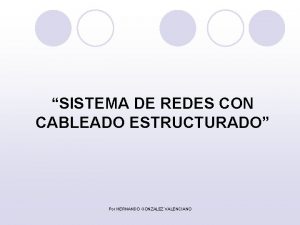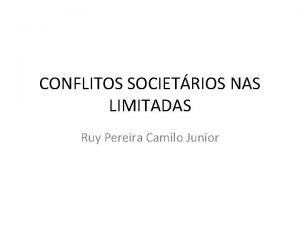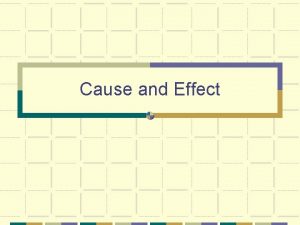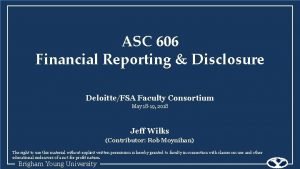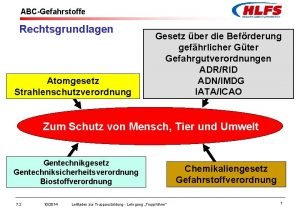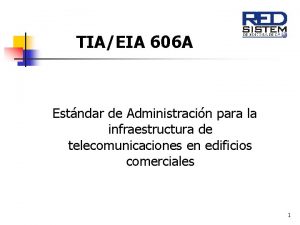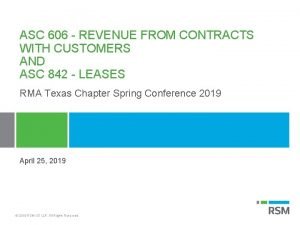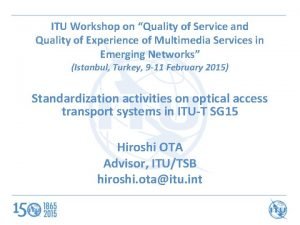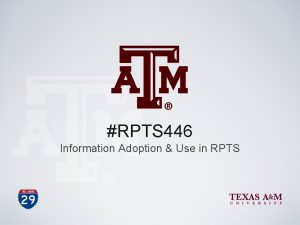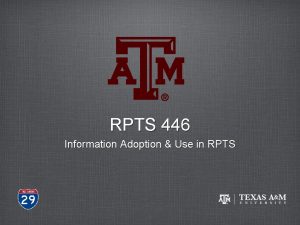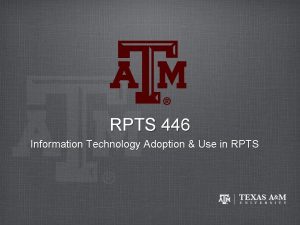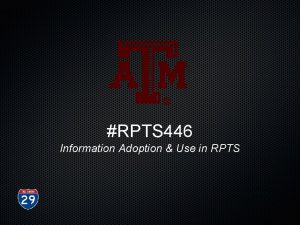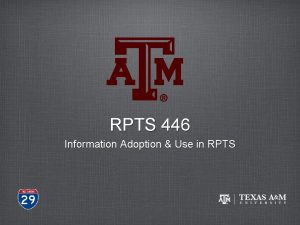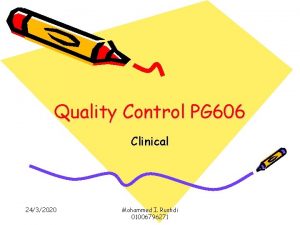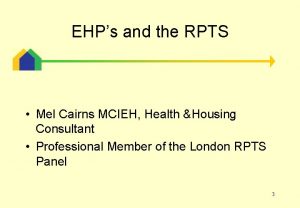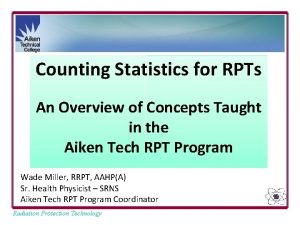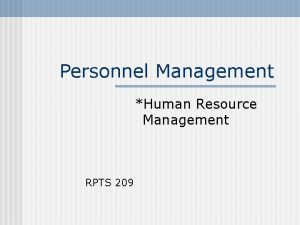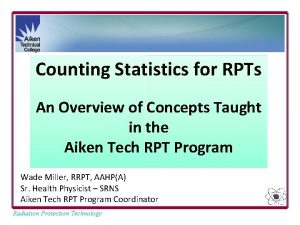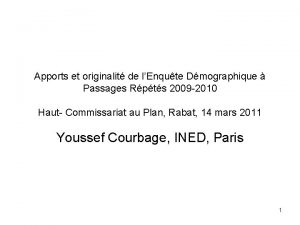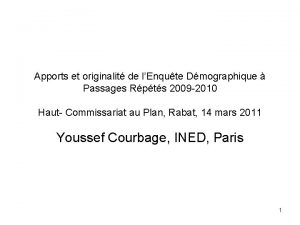Experience Quality MelyssaAnne Stricklin RPTS 606 Introduction n




















- Slides: 20

Experience Quality Melyssa-Anne Stricklin RPTS 606

Introduction n. Service Quality n. Satisfaction n. Delight n. Staging Experiences

Service Quality n “Service quality is an abstract and elusive construct because of three features unique to services: intangibility, heterogeneity and inseparability of production and consumption. n n (Parasuraman, Zeitham, & Berry, 1988) Two types of studies n Perceived quality (Zeithaml, 1987 and Parasuraman, Zeitham, & Berry, 1988) n Objective quality (Garvin, 1983 and Hjorth. Anderson, 1984)

SERVQUAL Parasuraman et al. (1988) created a multipleitem scale that measures consumer perceptions of service quality. n Five dimensions of service quality n Tangibles n Reliability n Responsiveness n Assurance n Empathy n

Satisfaction n Oliver (1980) stated that “satisfaction is a function of an initial standard and some perceived discrepancy from the initial reference point” n n Expectation is very important! “Satisfaction can be seen as an additive combination of the expectation level and the resulting disconfirmation” (Oliver, 1980) n Disconfirmation n Positive disconfirmation Surpassing consumers’ expectations Zero Disconfirmation Meeting consumers’ expectations Negative Disconfirmation Not meeting consumer’s expectations

Satisfaction n Oliver and De. Sarbo (1988) studied 5 factors that influence satisfaction n n n Disconfirmation positive, zero or negative Performance the transaction Expectation base line for comparison Equity whether or not the consumer is satisfied with what they put in compared to what they got out of the experience in comparison to someone else Attribution attribution theory is based on three dimensions “(1) locus of causality (internal versus external source of the cause), (2) stability (variability) of the cause of the outcome, and (3) controllability” (p. 496) Two most frequent influences were disconfirmation and performance

Satisfaction n Employee influence: (Bitner , Booms, & Tetreaulty, 1990 ) Underpaid and undertrained employees n P oor motivation n J ob dissatisfaction n High turnover of front of house employees n n Solutions n Training, motivating and rewarding employees that exhibit behaviors that bring about positive satisfaction

Satisfaction n Behaviors/actions that cause customer satisfaction/disatisfaction (Bitner, Booms, & Tetreault, 1990 n Employee response to service delivery system failures n Unavailable service, unreasonably slow services, etc Employee response to customer needs and requests n Unprompted and unsolicited employee actions n n Attention paid to customer, truly out-of-the-ordinary employee behavior, employee behaviors in the context of cultural norms, etc. ) .

Satisfaction n Why Satisfy? n Behavioral Intensions n n n Zeithaml et. al. (1996) created a model on Hypothesized Effects of Service Quality on Behavioral Intentions Boulding, Kalra, Staelin, and Zeithaml also create a model from expectations to behavioral intentions in 1993 Effect on profitability n n “Providing high quality and high customer satisfaction is rewarded by economic returns” (Anderson, Fornell, and Lehmann, 1994, p. 61) Return on Quality (Rust , Zahorik and Keiningham , 1995 ) n n (1) quality is an investment (2) quality efforts must be financially accountable (3) it is possible to spend too much on quality (4) not all quality expenditures are equally valid

Satisfaction n Satisfaction is not enough n “Zone of Tolerance” n n (Berry and Parasuraman, 1991, p. 58 A performance below the tolerance zone will engender customer frustration and decrease customer loyalty. A performance level above the tolerance level will pleasantly surprise customers and strengthen their loyalty” )

Delight n According to Finn ( 2005): n Affective and experiential emotional responses to consumption n n The secondary emotions created from a circular pattern of eight basic emotions n n Plutchik’s 1980 book, Emotion: A Psychoevolutionary The combination of joy and surprise n n n Westbrook (1987) and Holbrook & Hirschman (1982), respectively; Izard , 1977 Supported by Westbrook & Oliver, 1991 The effect of arousal on n Mano & Oliver, 1993 delight Synthesis

Delight n Oliver, Rust, & Varki (1997) n Results n Adam Finn (2005) reassessed the Oliver et al. (1997) n Agreed that S & D are two distinct concepts, but contradicted theory that D will only offer with very high involvement.

Delight n Three avenues to follow with Delight (Torres & Kline, 2012) n Confirmation - Disconfirmation paradigm n n n Oliver’s works Oliver, Rust & Varki, 1997 The satisfaction of human needs n n Outraged to delighted Humans are determined to satisfy core needs in life: security, justice, and selfesteem n n Schneider and Bowen (1999) Human emotions n Delight is a combonation of joy and surprise, or surprising joy n n Rust and Oliver (2000) Plutchik (1980) Kumar et al. (2001) Delight is one of the emotions in the high-arousal pleasure category n n Russell (1980) Watson and Tellegen (1985)

Delight n Is the bar too high? n Rust and Oliver (2000) created a mathematical model of delight n n Delighting heightens repurchase expectations Makes it more difficult to delight in the The non delighting competition is hurt worse because their customers leave and go to the delighting company. Authors suggest n n n Companies should either focus on practices not easily replicated by others Implement these delight practices when the competitors do not have the opportunity or the means Kumar et al. (2001) disagree with Oliver et al. (1997) that delight can only happen with surprise n “Firms may not have to constantly surprise their customers at every transaction to keep them delighted” (p. 25)

Delight n Product Attributes n n What features of a product or service cause satisfaction, dissatisfaction or delight Concentric rings of attributes n n Clemmer (1990) Levitt (1983) Built upon by Kano et al. (1984) Kano’s model is reflected upon by Oliver (1997) and Matzler et al. (1996)

Delight n Some of the Measurement Tools n n Oliver (1997) Likert type scale Crotts and Pan (2008) questionnaire

Delight n In other industries n Retail n n n Travel industry n n Torres and Kline (2006) Torres and Kline (2013) Magnini, Crotts, and Zehrer (2011) Theme Parks n Ma et al. (2013)

Staging Experiences n The Experience Economy (Pine and Gilmore, 1999) Fully themed n Perform to form n Appeal to multiple senses n Customization to the individual n Mix in memorabilia n Eliminate negative cues n

Staging Experiences n Ellis and Rossman, 2008

Conclusion n The purpose of my study will be to examine the effect of factors (such as theme, customization to the level of the individual, multisensory engagement and others) on experience quality (delight and engagement ) of event participants n Questions? ?
 Ansi/tia/eia-606-a
Ansi/tia/eia-606-a Asc 340-40-25-1
Asc 340-40-25-1 Artigo 606 cpc
Artigo 606 cpc Honda commercial 606 takes
Honda commercial 606 takes Asc 606 deloitte
Asc 606 deloitte Munitionsbrandklassen
Munitionsbrandklassen Tia/eia 606-a
Tia/eia 606-a Tia/eia 606-a
Tia/eia 606-a Regulamentul 606/2013
Regulamentul 606/2013 Asc 606 short term lease
Asc 606 short term lease Imprinting meaning psychology
Imprinting meaning psychology Continuity vs discontinuity
Continuity vs discontinuity What is indirect experience
What is indirect experience Quality & customer experience forum
Quality & customer experience forum Quality of experience
Quality of experience Adaptive bitrate
Adaptive bitrate Quality of experience
Quality of experience G.fast quality of experience
G.fast quality of experience Introduction to customer experience management
Introduction to customer experience management Introduction to customer experience management
Introduction to customer experience management Quality assurance vs quality control
Quality assurance vs quality control
